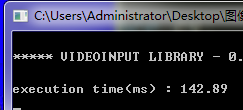图像分割系列5_GMM(高斯混合模型)对图像进行分割
本文共 2311 字,大约阅读时间需要 7 分钟。
实例5:GMM(高斯混合模型)图像分割
#include#include using namespace cv;using namespace cv::ml;using namespace std;int main(int argc, char** argv) { Mat src = imread("toux.jpg"); if (src.empty()) { printf("could not load iamge...\n"); return -1; } namedWindow("input image", CV_WINDOW_AUTOSIZE); imshow("input image", src); // 初始化 int numCluster = 3; const Scalar colors[] = { Scalar(255, 0, 0), Scalar(0, 255, 0), Scalar(0, 0, 255), Scalar(255, 255, 0) }; int width = src.cols; int height = src.rows; int dims = src.channels(); int nsamples = width*height; Mat points(nsamples, dims, CV_64FC1); Mat labels; Mat result = Mat::zeros(src.size(), CV_8UC3); // 图像RGB像素数据转换为样本数据 int index = 0; for (int row = 0; row < height; row++) { for (int col = 0; col < width; col++) { index = row*width + col; Vec3b rgb = src.at (row, col); points.at (index, 0) = static_cast (rgb[0]); points.at (index, 1) = static_cast (rgb[1]); points.at (index, 2) = static_cast (rgb[2]); } } // EM Cluster Train Ptr em_model = EM::create(); em_model->setClustersNumber(numCluster); em_model->setCovarianceMatrixType(EM::COV_MAT_SPHERICAL);//设置协方差矩阵 //设置停止条件,训练100次结束 em_model->setTermCriteria(TermCriteria(TermCriteria::EPS + TermCriteria::COUNT, 100, 0.1)); em_model->trainEM(points, noArray(), labels, noArray()); // 对每个像素标记颜色与显示 Mat sample(dims, 1, CV_64FC1); double time = getTickCount(); int r = 0, g = 0, b = 0; for (int row = 0; row < height; row++) { for (int col = 0; col < width; col++) { index = row*width + col; int label = labels.at (index, 0); Scalar c = colors[label]; result.at (row, col)[0] = c[0]; result.at (row, col)[1] = c[1]; result.at (row, col)[2] = c[2]; /*b = src.at (row, col)[0]; g = src.at (row, col)[1]; r = src.at (row, col)[2]; sample.at (0) = b; sample.at (1) = g; sample.at (2) = r; int response = cvRound(em_model->predict2(sample, noArray())[1]); Scalar c = colors[response]; result.at (row, col)[0] = c[0]; result.at (row, col)[1] = c[1]; result.at (row, col)[2] = c[2];*/ } } printf("execution time(ms) : %.2f\n", (getTickCount() - time)/getTickFrequency()*1000); imshow("EM-Segmentation", result); waitKey(0); return 0;}

 执行时间:
执行时间:
可见,GMM算法处理时间较长,并不适合工程实时图像处理。
转载地址:http://ezuhz.baihongyu.com/
你可能感兴趣的文章
NIFI从MySql中增量同步数据_通过Mysql的binlog功能_实时同步mysql数据_配置数据路由_生成插入Sql语句_实际操作02---大数据之Nifi工作笔记0041
查看>>
NIFI从MySql中离线读取数据再导入到MySql中_03_来吧用NIFI实现_数据分页获取功能---大数据之Nifi工作笔记0038
查看>>
NIFI从MySql中离线读取数据再导入到MySql中_不带分页处理_01_QueryDatabaseTable获取数据_原0036---大数据之Nifi工作笔记0064
查看>>
NIFI从MySql中离线读取数据再导入到MySql中_无分页功能_02_转换数据_分割数据_提取JSON数据_替换拼接SQL_添加分页---大数据之Nifi工作笔记0037
查看>>
NIFI从Oracle11G同步数据到Mysql_亲测可用_解决数据重复_数据跟源表不一致的问题---大数据之Nifi工作笔记0065
查看>>
NIFI从PostGresql中离线读取数据再导入到MySql中_带有数据分页获取功能_不带分页不能用_NIFI资料太少了---大数据之Nifi工作笔记0039
查看>>
nifi使用过程-常见问题-以及入门总结---大数据之Nifi工作笔记0012
查看>>
NIFI分页获取Mysql数据_导入到Hbase中_并可通过phoenix客户端查询_含金量很高的一篇_搞了好久_实际操作05---大数据之Nifi工作笔记0045
查看>>
NIFI分页获取Postgresql数据到Hbase中_实际操作---大数据之Nifi工作笔记0049
查看>>
NIFI同步MySql数据_到SqlServer_错误_驱动程序无法通过使用安全套接字层(SSL)加密与SQL Server_Navicat连接SqlServer---大数据之Nifi工作笔记0047
查看>>
NIFI同步MySql数据源数据_到原始库hbase_同时对数据进行实时分析处理_同步到清洗库_实际操作06---大数据之Nifi工作笔记0046
查看>>
Nifi同步过程中报错create_time字段找不到_实际目标表和源表中没有这个字段---大数据之Nifi工作笔记0066
查看>>
【Flink】Flink 1.9 版本 web UI 突然没有日志
查看>>
NIFI大数据进阶_FlowFile拓扑_对FlowFile内容和属性的修改删除添加_介绍和描述_以及实际操作---大数据之Nifi工作笔记0023
查看>>
NIFI大数据进阶_FlowFile生成器_GenerateFlowFile处理器_ReplaceText处理器_处理器介绍_处理过程说明---大数据之Nifi工作笔记0019
查看>>
NIFI大数据进阶_FlowFile生成器_GenerateFlowFile处理器_ReplaceText处理器_实际操作---大数据之Nifi工作笔记0020
查看>>
NIFI大数据进阶_Json内容转换为Hive支持的文本格式_实际操作_02---大数据之Nifi工作笔记0032
查看>>